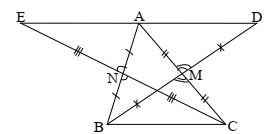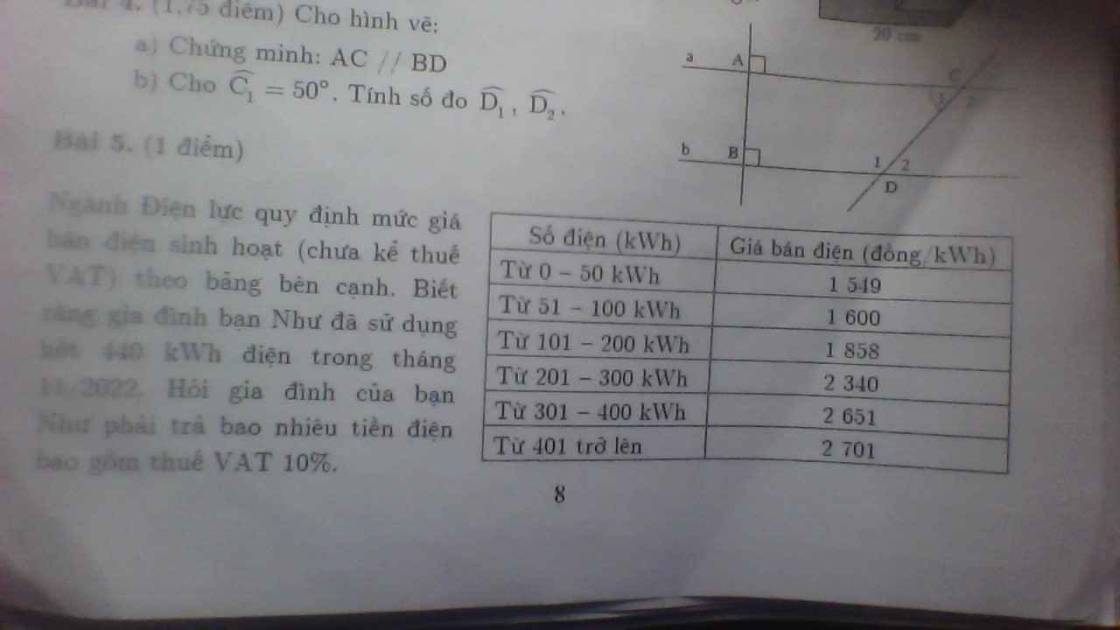\(TimXv\text{à}Ya.\left(2-X\right)\left(X+1\right)=|Y+1|\)
Hãy nhập câu hỏi của bạn vào đây, nếu là tài khoản VIP, bạn sẽ được ưu tiên trả lời.


(2\(x\) - 1).(2\(x\) - 5) < 0
Lập bảng ta có:
| \(x\) | \(\dfrac{1}{2}\) \(\dfrac{5}{2}\) |
| 2\(x\) - 1 | - 0 + + |
| 2\(x\) - 5 | - - 0 + |
| (2\(x\) - 1).(2\(x\) - 5) | + 0 - 0 + |
Theo bảng trên ta có: \(\dfrac{1}{2}\) < \(x\) < \(\dfrac{5}{2}\)
(3 - 2\(x\)).(\(x\) + 2) > 0
Lập bảng ta có:
| \(x\) | -2 \(\dfrac{3}{2}\) |
| 3 - 2\(x\) | + + 0 - |
| \(x\) + 2 | - 0 + + |
| (3 -2\(x\)).(\(x\) +2) | - 0 + 0 - |
Theo bảng trên ta có: - 2 < \(x\) < \(\dfrac{3}{2}\)

c, Gọi ƯCLN(a; b) = d; d \(\in\) k
⇒ d = 1944 : 108 = 18
⇒ a = 18.k; b = 18.n (k;n) =1; k;n \(\in\) N*
⇒18.k.18.n = 1944
⇒k.n =1944 : (18.18)
k.n = 6
6 = 2.3 Ư(6) = {1; 2; 3;6)
⇒(k; n) = (1; 6); (2; 3); (3; 2); (6; 1)
⇒ (a; b) = (18; 108); (36; 54); (54; 36); (108; 18)
Vì a> b nên (a; b) = (54; 36); (108; 18)
a, a + b = 72; Ư CLN(a; b) = 9 (a > b)
a = 9.k; b = 9.d (k; d) = 1; k; d \(\in\) N*; k >d
9.k + 9.d = 72
9.(k + d) = 72
k + d = 72 : 9
k + d = 8
(k; d) =(1; 7); (2; 6); (3; 5); (4; 4); (5; 3); (6; 2); (7; 1)
vì (k;d) = 1; k > d ⇒ (k;d) = (5; 3); (7; 1)
⇒ (a; b) = (45; 27); (63; 9)

B = \(\dfrac{1}{3}\) + \(\dfrac{1}{3^2}\) + \(\dfrac{1}{3^3}\) + ... + \(\dfrac{1}{3^{2020}}\) + \(\dfrac{1}{3^{2021}}\) < \(\dfrac{1}{2}\)
3.B = 1 + \(\dfrac{1}{3}\) + \(\dfrac{1}{3^2}\)+ ... + \(\dfrac{1}{3^{2019}}\) + \(\dfrac{1}{3^{2020}}\)
3B - B = 1+\(\dfrac{1}{3}\)+ \(\dfrac{1}{3^2}\) + ... + \(\dfrac{1}{3^{2019}}\) + \(\dfrac{1}{3^{2020}}\) - (\(\dfrac{1}{3}\)+ \(\dfrac{1}{3^2}\)+ ... + \(\dfrac{1}{3^{2020}}\)+\(\dfrac{1}{3^{2021}}\))
2B = 1 + \(\dfrac{1}{3}\) + \(\dfrac{1}{3^2}\)+...+ \(\dfrac{1}{3^{2019}}\) + \(\dfrac{1}{3^{2020}}\) - \(\dfrac{1}{3}\) - \(\dfrac{1}{3^2}\)- ...- \(\dfrac{1}{3^{2020}}\)-\(\dfrac{1}{3^{2021}}\)
2B = (1 - \(\dfrac{1}{3^{2021}}\)) + (\(\dfrac{1}{3}\) - \(\dfrac{1}{3}\)) + (\(\dfrac{1}{3^2}\) - \(\dfrac{1}{3^2}\)) +...+ (\(\dfrac{1}{3^{2020}}\) - \(\dfrac{1}{3^{2020}}\))
2B = 1 - \(\dfrac{1}{3^{2021}}\)
B = (1 - \(\dfrac{1}{3^{2021}}\)) : 2
B = \(\dfrac{1}{2}\) - \(\dfrac{1}{2.3^{2021}}\) < \(\dfrac{1}{2}\) (đpcm)

Bài 4: a, AC \(\perp\) AB
BD \(\perp\) AB
⇒ AC//BD (vì hai đường thẳng cùng vuông góc với một đường thẳng thứ ba thì song song với nhau.)
b, \(\widehat{C_1}\) + \(\widehat{C_2}\) = 1800 (hai góc kề bù có tổng bằng 1800)
⇒ \(\widehat{C_2}\) = 1800 - \(\widehat{C_1}\)
⇒ \(\widehat{C_2}\) = 1800 - 500 = 1300
\(\widehat{D_1}\) = \(\widehat{C_2}\) = 1300 (hai góc so le trong)
\(\widehat{D_2}\) = \(\widehat{C_1}\) = 500 (hai góc so le trong)

\(a-\dfrac{18}{a+1}=-4\) (ĐK: \(a>0,a\ne-1\))
\(\Rightarrow\dfrac{a\left(a+1\right)}{a+1}-\dfrac{18}{a+1}=-4\)
\(\Rightarrow\dfrac{a\left(a+1\right)-18}{a+1}=-4\)
\(\Rightarrow\dfrac{a^2+a-18}{a+1}=-4\)
\(\Rightarrow a^2+a-18=-4\left(a+1\right)\)
\(\Rightarrow a^2+a-18=-4a-4\)
\(\Rightarrow a^2+a+4a-18+4=0\)
\(\Rightarrow a^2+5a-14=0\)
\(\Rightarrow a^2+5a+\dfrac{25}{4}-\dfrac{81}{4}=0\)
\(\Rightarrow\left[a^2+2\cdot\dfrac{5}{2}\cdot a+\left(\dfrac{5}{2}\right)^2\right]-\dfrac{81}{4}=0\)
\(\Rightarrow\left(a+\dfrac{5}{2}\right)^2=\dfrac{81}{4}\)
\(\Rightarrow\left(a+\dfrac{5}{2}\right)^2=\left(\dfrac{9}{2}\right)^2\)
TH1: \(a+\dfrac{5}{2}=\dfrac{9}{2}\)
\(\Rightarrow a=\dfrac{9}{2}-\dfrac{5}{2}\)
\(\Rightarrow a=2\left(tm\right)\)
TH2: \(a+\dfrac{5}{2}=-\dfrac{9}{2}\)
\(\Rightarrow a=-\dfrac{9}{2}-\dfrac{5}{2}\)
\(\Rightarrow a=-7\left(ktm\right)\)
Vậy số thực dương a thỏa mãn là a = 2

A = \(\dfrac{22-3x}{4-x}\)
A = \(\dfrac{3.\left(4-x\right)+10}{4-x}\)
A = 3 + \(\dfrac{10}{4-x}\)
A lớn nhất khi \(\dfrac{10}{4-x}\) lớn nhất. Vì 10 > 0; \(x\) \(\in\) Z nên \(\dfrac{10}{4-x}\) lớn nhất khi
4 - \(x\) = 1 ⇒ \(x\) = 4 - 1 ⇒ \(x\) = 3
Vậy Amin = 3 + \(\dfrac{10}{1}\) = 13 khi \(x\) =3
Kết luận giái trị lớn nhất của biểu thức là 13 xảy ra khi \(x\) = 3



Chắc phải có thêm điều kiện x; y nguyên nữa chứ em?